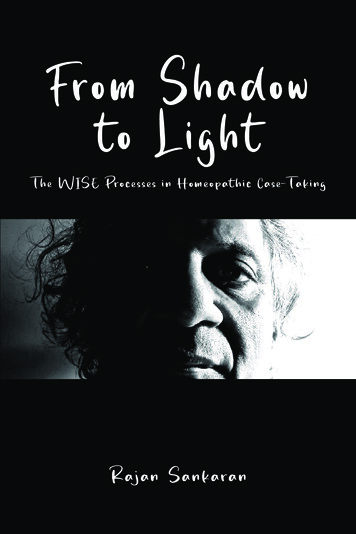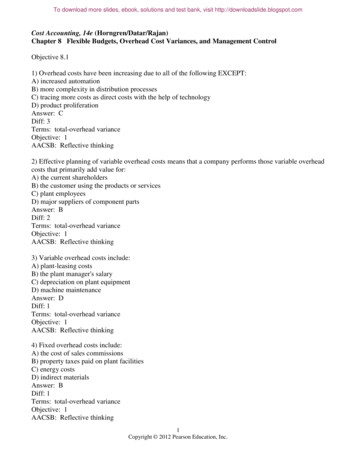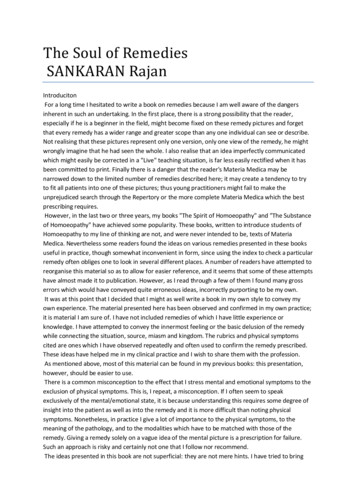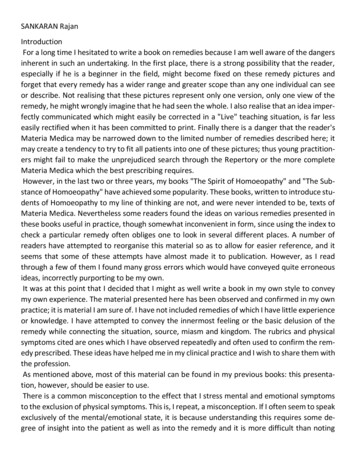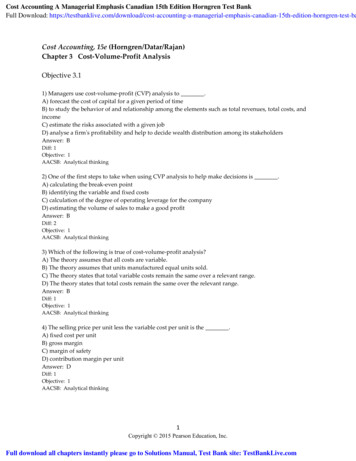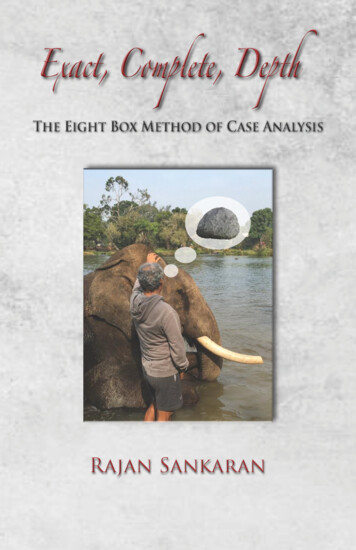
Transcription
Exact, Complete, DepthRajan Sankaran
Exact, Complete, DepthThe Eight Box Method Of Case AnalysisRajan SankaranHomoeopathic Medical PublishersMumbai, India
Dr. Rajan SankaranAll rights reserved. No part of this publication may be reproduced,transmitted, or translated into any language in India or abroadin any form or by any means without permission of the publisher.Printed in IndiaFirst Edition: 2018ISBN: 978-93-80355-67-2Printed at:SAP PRINT SOLUTIONS PVT. LTD., MUMBAI - 400 013Homoeopathic Medical Publishers201 Dinar, 20, Station Road, Santacruz (West), Mumbai - 400 054, IndiaTel.: 91 22 2605 8328E-mail: sales@onlinehmp.comWebsite: www.onlinehmp.com
The Blind Men and the Elephant(Abridged from the poem by John Godfrey Saxe)It was six men of HindustanTo learning much inclined,Who went to see the Elephant(Though all of them were blind)That each by observationMight satisfy the mind.And so, these men of HindustanDisputed loud and long,Each in his own opinionExceeding stiff and strong,Though each was partly in the rightAnd all were in the wrong.
AcknowledgementThis book was born out of the dedicated efforts of Dr. GaurangGaikwad and Dr. Aafreen Chunawala who have worked tirelesslyto collect and lay the informative groundwork that built thisproject.Dr. Gauri Avinashi has done a great job of compiling theinformation into book form, a creditable maiden work for her.Armeen Jasavala has edited the book to bring out my conceptswith clarity and conciseness while retaining their originality.I am grateful to Dr. Meghna Shah for her exacting reviews andsuggestions, which acted to enhance the value of this book.Dr. Kshiti Mehta has spent many hours correcting the errors andexpressions. She tirelessly worked to improve the presentationof all the graphical contents in the book.Dr. Gentiana Ciubuc, Dr. Juan Carlos Galante and Dr. NoraCaram have made very valuable contributions to the book withtheir cases and foreword. Gentiana has also worked very hard atcreating the wonderful cover page.I extend my gratitude to Mr. Haresh Shah for giving the physicalform to all my ideas and for his diligent efforts in the publicationof this work.Mr. Jayesh Parikh from our in-house team extended his supportto address all changes required in presentable format in thisbook.Many thanks to Anju Melwani for the illustration of the blindmen and the elephant.This book is my humble offering to the students and practitionersof homeopathy who are the torchbearers of this wonderfulscience that continues to heal at all levels.
ContentsForeword9Introduction11Evolution: From Synergy to The Eight Box Method15The Elements of The Eight Box21Exactness, Completeness, Depth37Matching the Intensity41Hints on Case Taking43Case Taking according to Levels of Experience49Working a Case with The Eight Box Method53Confirmation57Cases Illustrating The Eight Box Method1. Case of Allergic Bronchitis and Constipation612. Case of Panic Attacks673. Case of Eczema754. Case of Hemorrhoids835. Case of Polycystic Ovarian Syndrome936. Case of Ankylosing Spondylitis1017. Case of Trophic Ulcer1138. Case of Anxiety Disorder1219. Case of Anxiety Neurosis131Possible errors with The Eight Box Method151Thinking Out of the Boxes157Activity Case161Afterword163
ForewordA few years ago, during a seminar in Mumbai at The Other Songacademy we witnessed a live case by Dr. Sankaran. At that time,he had not yet developed his analysis system with the EightBoxes.During this case, amongst the other symptoms, the patientdescribed a feeling of lightness, the delusion of flying and afeeling of being under pressure. We were swept away by thatdelusion and completely forgot what the patient said at thebeginning of the consultation, the main issue being fear andterror. We did not even consider the general or local symptoms.Our mind automatically jumped to the most well-known place,the sensation. We thought that the patient needed a plantremedy from the Hamamelidae family and we totally missed theremedy.At that time, we did not have the eight-box tool to help usrecognize the unconscious pattern, the other song, thenoumenon that was unfolding before us in every aspect of thepatient. The idea of its existence was present, but we lackedthe appropriate instrument to keep our attention active in allareas of the patient’s story, as to recognize the level where thepattern is most clearly manifested and to find it on every level.With the resource of the Eight Boxes, the case unfolds as witha prism that breaks a light beam and then we can assemble itsparts again. In each color the whole is implied. Eventually thatprism would be internalized, and we could look at everything ina fragmented way and then watch it come together again.The Eight Box method is a priceless tool for analyzing andsummarizing a case for prescription, teaching and follow-ups.It is a helpful resource that is dynamic and flexible in the sensethat it is the patient who determines the structure of each box.9
In this way, the prescription easily achieves the three parametersthat Dr. Sankaran emphasizes: exactness, completeness anddepth.Dr. Nora Caram and Dr. Juan Carlos GalanteBuenos Aires, ArgentinaMarch 2018Dr. Nora Caram and Dr. Juan Carlos Galante are experienced homeopathsfrom Buenos Aires, Argentina. They have studied under Dr. Masi Elizaldeand Dr. E. Candegabe among others, before studying the sensation methodand following its evolution into the Synergy and the Eight Box. They now runcourses on these approaches in Buenos Aires. They have been kind to writethis foreword as well as share an interesting case from their practice illustratingthe Eight Box Method that you will see later in this book.10
IntroductionThe parable of the blind men and an elephant originated inthe ancient Indian subcontinent, from where it has been widelydiffused. It is a story of a group of blind men, who have nevercome across an elephant before and who learn and conceptualizewhat the elephant is like by touching it. Each blind man feels adifferent part of the elephant’s body, but only one part, such asthe side or the tusk. They then describe the elephant based ontheir partial experience and their descriptions are in completedisagreement on what an elephant is. In some versions, theycome to suspect that the other person is dishonest, and theycome to blows.The parable has been used to illustrate a range of truths andfallacies; broadly, the parable implies that one’s subjectiveexperience can be true, but that such experience is inherentlylimited by its failure to account for other truths or a totality oftruth.The situation is similar in homeopathy. Different methodologiesand approaches view the case in different ways and often cometo different conclusions. One possible solution is to look at thesame case from different angles to get the whole picture.11
Evolution: From Synergy toThe Eight Box MethodIn homeopathic practice, the intention is to make the task ofperceiving the morbid state and selecting the appropriateremedy simple, consistent, definite and systematic, to ensurerecovery in every individual case of disease.Thirty-five years of clinical practice along with a deep groundingin Materia Medica, Provings and Repertory, has brought withit an on-going evolution and refinement in my approach ofpractice. With a firm grounding on the fundamental principles ofhomeopathy and a mind that is open and receptive to nuances,I have come to a stage where I use many approaches in mypractice, which requires both acceptance and flexibility.As we know, homeopathy is based on the law of similars,which means the remedy must match the patient, but thenwhy are there so many different approaches? These differencesarise because of a difference in opinion over what needs tobe matched. Throughout history, this has been the burningquestion.Some homeopaths advocate a practice based on specificremedies for modalities and locations. For example: pain in thejoints that is better by motion is Rhus toxicodendron and if thepain is worse from motion the remedy is Bryonia. Or a left-sidedheadache is Spigelia and a right-sided headache is Sanguinaria.15
The Elements ofThe Eight BoxThe greatest advantage of the Eight Box method is flexibility.Though each case should ideally be complete in each of theEight Boxes, we may not encounter such cases in practice. If anyof the boxes are not clear in the case, despite our best efforts,we should not try to force something into it. Instead we shouldlook at the other boxes which are clear.Also, it is very important to note here that in every case onemust not enter information into the Eight Boxes mechanically.It is to be done with the same artistic approach of selecting thepeculiar, queer, rare and strange symptoms of the patient thatrepresent the most characteristic and individualizing aspects ofthe case.Let us look at each of the Eight Boxes in depth for furtherunderstanding.PATHOLOGYMany, if not all patients approach the physician with apathology, which means a particular organ is presenting asthe seat of disease. At times, the pathology itself may be veryunique or rare. In this case it becomes valuable information andwe can refer to the materia medica to find the organ affinitiesand pathology-specific remedies. This box is very important21
Exactness, Completeness, DepthThe Eight Box method of case analysis is mainly useful to reducethe common errors we make in practice. The biggest mistake inpractice is that we tend to look at a part of case and make aconclusion. Also, many-a-time we are guilty of not going intothe depth and eliciting exact details of each area.I started to think of how we can reduce these errors and thethree words that came to me were exactness, completenessand depth.In the dictionary, exactness is the quality of being accurate,correct or precise and completeness is the state or condition ofhaving all the necessary or appropriate parts. In homeopathiccase taking, both exactness and completeness are necessaryfor the successful application of the Eight Box method of caseanalysis and prescription.The third word I focused on was depth because I truly believethat every aspect, window, box, or area is important and needsto be examined at great depth. The characteristics must beelicited, recorded, categorized and classified in the most minuteof details.The categories that denote the depth are miasm, experience,sensation and modalities. I had an interesting case of a young37
Matching the IntensityAnother critical concept to think of is matching the intensity andcore pattern of the patient with the intensity of symptoms in theremedy. For example, we had a patient who had several fears,pointing to the remedy Calcarea carbonica. She was 25-yearsold when she gave birth to her baby. She felt that it was a hugeresponsibility, which she was not ready to take. She developeda mild aversion and did not feel tremendous love for the baby.She liked traveling but the fact was that she hardly travelled.Even on being asked where she liked to go, she was not veryexpressive and she had no compulsion to travel.At the time of the live case explanation, one student askedme why I did not give Calcarea phosphorica because of thedesire to travel and indifference to her child. The answerI gave focused around the matching of the remedy. One cannottake a common, mild desire to travel and match it to Calcareaphosphorica, which has an intense desire to travel. One cannottake this behavior as an aversion to responsibility, because atthe depth we understand the patient is like a child herself,incapable to support her own needs. We cannot concludethat this indifference to the family is the same of Phosphorus,because in Phosphorus this feeling arises out of a desire tomake contacts outside of the family. But this particular womanwas very unsocial and she wanted to be at home with support.41
Hints on Case TakingLike every other art, case taking too becomes more refined andeasy with practice.Here are some of the key points that I use in my case taking:OPEN LISTENINGWithout interrupting the patient, I observe what expressionsand words come frequently in different areas of the case. Onlyif the words or expressions are repeated do I ask about them,and I definitely not ask the first time the patient mentions them.If the homeopath asks too early, one can mislead the patientunless they are sure that the words or expressions have a deepersignificance.DISSOCIATEWhen I am sure that a word has a lot of significance for thepatient, then I take the word and tell the patient to forget thesituation or context in which the word was mentioned and tellme whatever comes up for them spontaneously when they thinkof the specific word.43
Case Taking according toLevels of ExperienceIn the first ten minutes of the case taking, I usually wait andscan what the patient says to see whether the narrationspontaneously flows from the level of facts, emotions, delusionsor sensation, and then decide which of these will yield the mostvaluable information without resistance.It is very important to understand that different cases requiredifferent techniques of case taking. Let us look at each type ofcase in detail.CASES OF PATHOLOGYIf in a case we see that the most prominent symptoms are inthe pathology it means that the individualizing symptoms arefew. If the pathology is peculiar you must find the remedies forthat specific pathology. If you have six remedies covering thepathology, you need to look for a concomitant that helps you tofind the exact match.I had a case of urethral stricture in a 1-year-old child. Here,the pathology itself is peculiar, why would a child of this agedevelop urethral stricture? I looked briefly in the repertoryfor urethra stricture and then I proceeded to ask about othersymptoms. As I was investigating the generals, I got the mostpeculiar symptom in the perspiration area. This child perspired49
ConfirmationThe last step of the Eight Box method of case analysis is theconfirmation. We must match the essence of the patient to theessence of the remedy.It is very important to know that it is not necessary that everysymptom of the remedy be present in the patient.Every remedy according to the kingdom has its essentialquality that must be present in the patient. There are certaincore qualities that make the remedy what it is. For example,the essential qualities in Sulphur are inquisitiveness, theorizingand a feeling of, “I am better than you”, but not in the way ofcomparison in the animal kingdom but as an assertion of hisidentity.Let us illustrate this with more practical examples.If one wants to prescribe Staphysagria, the patient must haveextreme sensitiveness at the core of the case with the needto control. There must be issues of wounded honor, selfrespect, sexuality, and finally, a feeling of “I must control mypassion- whether it is anger or sex. If I fail to control it, I will beembarrassed and I am so sensitive that I cannot take it”. Thenwe have the physical manifestations and confirmations of angerwith trembling, redness of face, and loss of voice.57
Cases illustratingThe Eight Box Method
1. Case of Allergic Bronchitisand ConstipationThis is a case of a 3-year-old boy who came to us with thecomplaint of recurrent allergic bronchitis and constipation thatwas present for one and a half years.His mother reports he has a cough that occurs more at nightduring sleep and in the morning. He goes red in face whilecoughing without expectoration. The constipation is painfuland the stool recedes when he has the urge to defecate. Hesweats profusely around the hairline and prefers uncovering insleep. The mother explains there is a very peculiar symptomwhere whenever a mosquito bites him anywhere on his body, hedevelops a big swelling of the left eyelid overnight. This to mewas very strange and characteristic.The mother describes him as a very emotional and affectionatechild who loves to cuddle and cling. He is very sensitive tothe emotions of others. He would cuddle people to makethem feel better when they were affected emotionally. He isdeeply affected by separation and people going away. He isuncomfortable in a crowd but is happy in familiar places. Hedoes not like noise. He loves to dance, enjoys rhythmic musicand loves to remain active and play. He has a fear of loud sounds.61
AfterwordThis book is part of the ongoing evolutionary journey to achievemore consistent results in practice.The journey began with the understanding of fundamentalhomeopathic concepts such as holism and individualism and theidea of the dynamic nature of health and disease. From theseconcepts came the understanding of the central disturbanceas represented by the mind state and the general symptoms.Simultaneously there was a recognition of the importance ofpeculiar symptoms with the concurrent development of theskills of using of the repertory, materia medica and provings.At this point the journey went further with the understandingthat the mind state was an expression of individual’s perception(delusion), knowing which assumed importance. In a furtherdevelopment, the ‘delusion’ was seen as an expression ofa deeper experience or ‘sensation’. The idea of classifyingsensations into the three kingdoms was the next significant step.It was also discovered that each sensation can be expressed at acertain pace (miasm).It was observed that each patient has a specific aspect in theircase that is clearer than the others, delineating their level ofexperience. Seven such levels were identified.163
Resources forFurther Learning173
Books by Homoeopathic Medical Publishersrecommended byDr. Sankaran for step by step learning in HomoeopathyBOOKCONCEPT(S)The Elements ofHomoeopathyThis book illustrates practically every aspect ofhomoeopathic medicine, whether it is the studyof Materia medica, Hints on Case-Taking, Valueof Repertory, Cross References to the Repertory,Difficulties in Practice and The Scope of Homoeopathy.Dr. P. SankaranThe Spirit ofHomoeopathyDr. Rajan SankaranThe Substance ofHomoeopathyDr. Rajan SankaranThe Soul of RemediesDr. Rajan SankaranThe System ofHomoeopathyDr. Rajan SankaranSensation RefinedDr. Rajan SankaranThis book is divided into four sections: Philosophy,The Mind, Case-Taking and Finding the Remedy, andMateria medica. The first section looks at what diseaseis - the origin and the dynamics of disease. The secondinvestigates the understanding of delusions, mentalstate as a whole and body-mind connection. The thirdsection covers the artistic aspect of homoeopathy,understanding the patient. The final section furthersthe understanding of remedies, and includes remediesas examples.This book illustrates how delusions can be classifiedusing Hahnemann’s theory of miasms. A detailed studyof homoeopathic drugs with reference to their sourcerevels the purpose of the traditional classification intoplant, animal and mineral kingdom.Clear, concise, confirmed descriptions of the innerview of a hundred different remedies and how theyexpress this in clinical situations.The method of case-taking, its analysis and detailedfollow-up is well illustrated with hints and guidelines, itdeals with the understanding the mental state, elicitingthe mind and body connection, central delusion, whatto do and what not to do with dreams, plus a furtherunderstanding of miasms and kingdoms.This book addresses the problems and pitfallsthat seekers in this method face. It answers manyqueries about the sensation and its expression, andhow to understand it better, in a clearer and simplerway. Here, there is a deeper understanding of theexperience, living it and seeing almost nothing else.175
Exact, Complete, DepthBOOKThe Sensation inHomoeopathyDr. Rajan SankaranAn Insight into Plants(Volumes 1, 2 and 3)Dr. Rajan SankaranSankaran’s SchemaDr. Rajan SankaranStructure - Experienceswith the MineralKingdom(Volumes 1 and 2 )Dr. Rajan SankaranSankaran’s PlantSensation in PictureDr. Rajan SankaranSandra PetriCONCEPT(S)Using numerous case examples, this book gives onethe ability to know at all times in a given case, whereto begin and where to aim, through The Seven Levelsof Experience. It gives a definitive pathway for casetaking, a means by which to observe and utilize theactive energy patterns of the patient (hand gesturesand movements), plus a way of matching the patient’slevel to the remedy and potency that is required.This book provides a framework of how the plantkingdom can be classified and understood. Tracingthe common sensation of each family, this bookshows how this sensation can be seen in the remediesin that family. The remedies are differentiated by themiasm to which they belong.This book aims to bring in a nut shell, in a tabulatedform, the different concepts and informationspread over Dr. Sankaran’s books - The Spirit ofHomoeopathy, The Substance of Homoeopathy,The System of Homoeopathy, The Sensation inHomoeopathy, and An Insight into Plants (Volume I,II, III), and Sensation Refined.The periodic table readily lends itself to the task ofclassification. Its seven rows and 18 columns can beunderstood, seen and experienced as stages of humandevelopment. Recent explorations into the rows,backed by several clinical cases, provings and research,have thrown new light on the Mineral Kingdomthat makes it significantly easier to recognize theremedies in practice.As they say 'One picture is worth a thousand words'.In this books Sandra Petri's visual representationsis aligned to Dr Sankaran’s experience of thePlant families. The idea of the whole book is tobe informal or more at an artistic level rather thansomething very structured or formal. It is offered tostudents and practitioners of homoeopathy with thetrust that it will further help in getting not only thewords of each family but an actual live experience bya look at the illustrations.176
Resources for Further LearningBOOKCONCEPT(S)Survival - The MolluscWithin are described the qualities of Mollusca innature, its subdivisions, and expressions in the humanbeing. Each of these is described with source words,proving information and clinical cases, to make iteasy to recognize in clinical practice.Dr. Rajan SankaranDr. Sudhir BaldotaSurvival - The Reptile(Volume 1 and 2)Dr. Rajan SankaranDr. Meghna ShahThe Synergy inHomoeopathyDr. Rajan SankaranSynergy SynopsisDr. Rajan SankaranJust You SeeDr. Sunirmal SarkarWithin are described the qualities of Reptilia innature, its subdivisions, and expressions in the humanbeing. Each of these is described with source words,proving information and clinical cases, to make iteasy to recognize in clinical practice.An integrated approach to case-taking and analysis.Never before has the connection between the patientand the remedy been so clear - symptoms and systemare two sides of the same coin and this results from anintegrated approach. Both the factual and conceptualaspects of the patient and the remedy must be seentogether. The knowledge of old masters, such as C.M.Boger, is explained in detail. Through illustrativecases, the secret of success is depicted through thisintegrated approach. Through a seamless blendingof the old and new, conventional and contemporary,the results are proof of a quantum leap inhomoeopathic practice.This book is a small handbook, updated with thelatest developments in advanced homoeopathicpractice. It is intended to be a ready reference guidefor participants who attend seminars, and for otherswho wish to have an overview of this system ofpractice.This is a book which brings to light the many differentapproaches and clinical Materia medica of Dr. SunirmalSarkar. He is one of busiest homeopathic practitionersin Kolkota, India and sees up to 100 patients a day,50 of which are cancer cases. This book also describesin depth the different sources and methods which helpto solve cases, such as Materia medica, the Repertory,Indian Drugs, Potentised Allopathic Drugs, Sarcodes,and Organ Remedies amongst others.177
Exact, Complete, DepthBOOKCONCEPT(S)From Similia to Synergy From Similia to Synergy guides the reader through theDr. Rajan Sankaranfull spectrum of homoeopathic knowledge. Sankarandemonstrates integration with actual case sudies. Casetaking discourses have been transcribed and parsed toallow the reader to understand the Sankaran’s thoughtprocesses. Thoughout, the reader is encouraged to referto supporting bodies of work for further research andcomprehension.The Art of Follow-UpDr. Rajan SankaranPathology Factor inRemedy SelectionDr. Ashok BorkarIt is often said that it is easier to come to a remedyselection than managing the follow up. Most of thedifficulties that arise in follow up management includehow and when to repeat a remedy, when to escalate thepotency, when to change the remedy and so on. Whenmastered, the art of follow up is the key to developinga successful and satisfying homoeopathic practice.Dr. Rajan Sankaran explains the intricacies andimportance of the follow up alongside illustrative caseswith long-term follow ups from his 30 years of practice.He sees a patient beyond their disease, connects tothem at a deeper level, manages critical situationsfaced by the patient (in health or personal lives) asa homeopath, friend, guide and philosopher, andtherefore demonstrates how to effectively encouragethe patient to adopt essential changes in their lifestyleincluding diet, exercise, yoga and meditation.This book is a result of intense study by Dr. AshokBorkar. With the help of successfully solved casesit demonstrates the role of the pathology factor inremedy selection. The technique that he has used andadvocated in this book is so simple that any homoeopathwho reads this book should be able to apply it easily inhis practice and produce amazing results.Dr. Rajan Sankaran sums up the vital learning that willbe derived from this book in its foreword, “ This bookby Dr Ashok Borkar, his first one, is an important contribution.It highlights the fact that beyond matching the Sensation and theSymptoms of the patient with the remedy, one also has to considerif the Genius matches too. This facilitates healing at the deeperlevels and not only relief of symptoms or state of mind.”178
Resources for Further LearningBOOKConquering Fevers withHomoeopathyCONCEPT(S)Fever cases cause panic in patients and doctors as well.But chill!Dr. GajananDhanipkarAs a homoeopathic physician, armed with the standardmateria medicas and repertories, and applying basicskills of observation, clinical examination and remedyanalysis, you can certainly conquer fevers in practice.In this his first book, Dr. Gajanan Dhanipkar MD(Hom) unfurls the simple and practical methodsof approaching, solving and handling fever caseshomoeopathically. It is amply illustrated with casesfrom his daily practice, including diagnoses, analysischarts and results verified by laboratory reports.It is a masterpiece of a clinically verifiable practicalapplication of homoeopathy.Dog, Yogi, Banyan TreeDr. Rajan Sankaran“If you are open to learn, everyone and everythingbecomes your teacher.”Told through a series of fascinating vignettes, Dog,Yogi, Banyan Tree brings alive Dr. Rajan Sankaran’smeetings with various people and situations to forma rich tapestry of his experiences. Starting from hisformative years with his father, he takes us on anundulating journey where ordinary people, gurus, atree and even a dog leave an everlasting impression.The anecdotes, steeped in introspection of ethics, love,friendship, passion, coincidences, criticism, challengesand spirituality, strike a chord with us all. The stories,insightful yet amusing, may seem unconnectedinitially, like threads of different hues hanging loosely,but soon they are deftly woven into a larger picture.It is a tale of personal evolution and spiritual discoverythat both touches the heart and heals the soul.To know more about this book visit:www.dogyogibanyantree.com179
Wednesdays With Rajan - 1 & 2An Incredible step-by step,Comprehensive, Learning Opportunityat your doorstep.WWR 1 - holds an indomitable reputation of being one of the mostsuccessful online training program in the history of homoeopathy.Dr. Rajan Sankaran has presented, for the first time, a comprehensiveonline talks of 102 hours.Wednesdays With Rajan- 1 is a crystallisation of the 30 years of his busypractice where he successfully integrates traditional homoeopathicknowledge of the Organon, Materia Medica and Repertory with hisorigination, the Sensation Method.WWR - 2Wednesdays With Rajan -II takes the concept of online programs to a wholenew level - from fundamentals to mastery.This program shows how the Sensation Method and other contemporaryadvanced methods are used in practice and is integrated with allconventional approaches in a harmonious synergy for much greatereffectiveness in practice.In this course, Dr. Rajan Sankaran is joined by 23 of the world's leadinghomoeopathic practitioners, each bringing their own unique flavour tohomoeopathic practice.All talks are pre-recorded. You can view them as per your convenience.You will get access for 15 months from the date of access activation.Homoeopathic Medical PublishersContact : sales@onlinehmp.comwww.onlinehmp.com180
Wednesdays With Rajan - 3The Newest Evolution in practiceThe Eight Box MethodLearn the Art & Skill of Case Taking& Follow-Up with Dr. Sankaranfrom the comfort of your home!WWR-3 focuses on the newest evolution in practice, including the Synergyapproach and The Eight Box Method. It also highlights the importance ofthe techniques used in follow-ups and how to manage long-term follow-upsin practice.In these lectures, Dr. Sankaran goes into great detail and explains theprocess of case-taking and analysis with step-by-step instructions, allowingparticipants to get a sneak-peak into his own thought process andunderstanding of the art of homeopathy.All talks are pre-recorded. You can view them as per your con
Dr. Rajan Sankaran, M.D. (Hom), is a homeopath, thinker, teacher and author who is known around the world for his revolutionary concepts in homeopathy. As a boy, he would help his father, Dr. P. Sankaran in repertorizing cases, which made him well versed with the repertory from a very young age. His conviction



